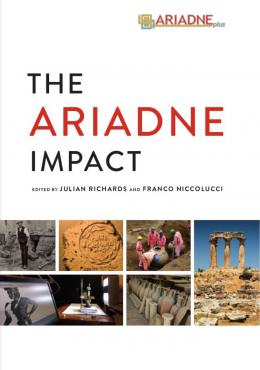The Ariadne Impact

The Ariadne Impact
| 0 Ft |
| Price |
Project: ARIADNEplus
Budapest, Archaeolingua, 2019
Keménytábla | Hardcover
199 oldal, színes és fekete-fehér illusztrációkkal | 199 pages with colored and grayscale images
ISBN 978-615-5766-31-2
The book is available as pdf on the project’s website.
If you would like a printed copy, please contact us at info@archaeolingua.hu.
Description
Research e-infrastructures, digital archives, and data services have become important pillars of 21st-century scientific enterprise. The archaeological research community was an early adopter of digital tools for data acquisition, organization, analysis, and presentation of research results of individual projects. However, the provision of services and tools for data sharing, discovery, access, use and re-use has lagged behind. This situation is being addressed by ARIADNE, and its follow-on project ARIADNEplus. This volume introduces ARIADNE and provides national perspectives from ARIADNE and ARIADNEplus partners on the current and anticipated impacts of this international collaboration in their own countries and beyond. The publication was funded by the European Commission under the H2020 Programme, as part of the ARIADNEplus project.
Table of contents
1. ARIADNE and ARIADNEplus. Franco Niccolucci, Julian Richards
2. Crossing mountains and digging tunnels from our own backyard
to our neighbours. Valentijn Gilissen, Hella Hollander
3. The advantage of participating in an EU-project. Ulf Jakobsson
4. The impact of European cooperation on national archaeological research
organisations: The example of ARIADNE and Inrap. Kai Salas Rossenbach, Amala Marx, Emmanuelle Bryas
5. ARIADNE and ARIADNEplus in Austria. Edeltraud Aspöck
6. The Hungarian archaeology database in the light of ARIADNE. Attila Kreiter
7. The Zbiva Web Application: a tool for Early Medieval archaeology
of the Eastern Alps. Benjamin Štular
8. The Italian Geoportal for Archaeology: a new tool for archaeological data integration and reuse. Valeria Acconcia, Valeria Boi, Sara Di Giorgio, Annalisa Falcone, Paola Ronzino
9. From ARIADNE to ARIADNEplus: Developing the concept of archaeological digital data and increasing its ‘FAIRness’. Sorin Hermon, Valentina Vassallo
10. Portuguese cultural heritage data access tools and policies – anticipated impacts of ARIADNEplus. Maria João Correia, António Santos Silva, Filipa Neto, Miguel Martins
11. CENIEH: A relevant source of digital paleoanthropological datasets for ARIADNEplus. Mohamed Sahnouni, Maria Isabel Sarró Moreno, Cecilia Calvo Simal
12. The ADED project – a Norwegian infrastructure for excavation data. Christian-Emil Smith Ore, Espen Uleberg
13. DataArc: a case study using CIDOC CRM as an ontology for transdisciplinary research. Gísli Pálsson, Rachel Opitz
14. MASA Digital ecosystem for the French archaeological community. Olivier Marlet, Xavier Rodier
16. Archaeological digital repositories: Fostering networks from the Global South. Andrés Darío Izeta, Roxana Cattáneo
17. Prospects and potential for the comprehensive database of archaeological site reports in Japan. Yuichi Takata, Akihiro Kaneda, Dessislava Veltcheva
18. Innovation and Impact of the ARIADNE Initiative. Guntram Geser
| |
|
|
1067 Budapest, Teréz krt. 13. |
|
|
|
|
About us
The Archaeolingua Foundation and Publisher is involved in publishing series and standalone publications in the disciplines of archaeology, linguistics, historic sciences and heritage protection for over 25 years.
Learn more
Publishing
We publish both as standalone editions and as a volume of a professional series.
Learn more
Contact us
Archaeolingua Foundation

